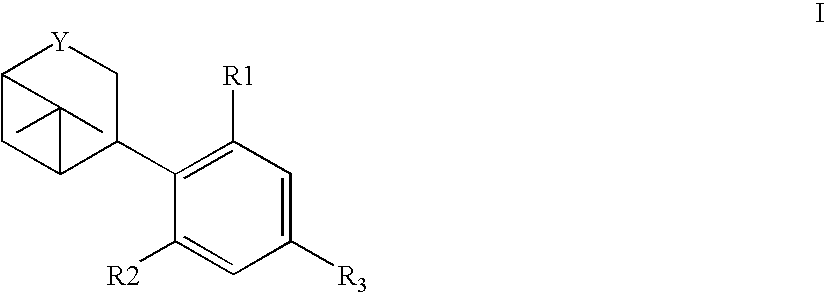Novel bicyclic and tricyclic cannabinoids
a cannabinoid and tricyclic technology, applied in the field of cannabinoid analogs, can solve the problems of non-receptor mediated brain function impairment, unsatisfactory side effects, and impaired monoamine oxidase function, and achieve the effects of reducing endotoxic shock and hypotensive shock, reducing side effects, and reducing side effects
- Summary
- Abstract
- Description
- Claims
- Application Information
AI Technical Summary
Benefits of technology
Problems solved by technology
Method used
Image
Examples
examples
[0120] Bicyclic-cannabinoid hybrids of compound formula I, II and III were synthesized with different R groups and different Y, B, G functionalities are depicted in Table 1. The CB1 and CB2 binding affinity value (Ki) for the synthesized analogs range between 31-224 nM and 0.2-77 nM respectively.
TABLE 1Novel Bicyclic-cannabinoid analogs of compound formula I, II and III.Ki in nMKi in nMfor thefor theCompoundYCB1CB2numberFunctionalityR1R2R3ReceptorReceptor2aOHOH50.60.42bOHOH74.50.42cOHOH223.510.92dOHOH10.69.32eOHOH30.80.23OHOH133.276.8
[0121] Hexahydrocannabinol derivatives of compound formula IV, V and VI were synthesized with different R groups and different X, Q, M functionalities are depicted in Table 2. The CB1 and CB2 binding affinity value (Ki) for the synthesized analogs range between 0.1-12 nM and 0.2-14 nM respectively.
TABLE 2Novel Hexahydrocannabinol analogs of compound formula IV, V and VI.Ki in nMfor theKi in nM forCompoundXCB1the CB2numberFunctionalityR1R3ReceptorRec...
PUM
| Property | Measurement | Unit |
|---|---|---|
| volume | aaaaa | aaaaa |
| temperature | aaaaa | aaaaa |
| temperature | aaaaa | aaaaa |
Abstract
Description
Claims
Application Information
 Login to View More
Login to View More - R&D
- Intellectual Property
- Life Sciences
- Materials
- Tech Scout
- Unparalleled Data Quality
- Higher Quality Content
- 60% Fewer Hallucinations
Browse by: Latest US Patents, China's latest patents, Technical Efficacy Thesaurus, Application Domain, Technology Topic, Popular Technical Reports.
© 2025 PatSnap. All rights reserved.Legal|Privacy policy|Modern Slavery Act Transparency Statement|Sitemap|About US| Contact US: help@patsnap.com



